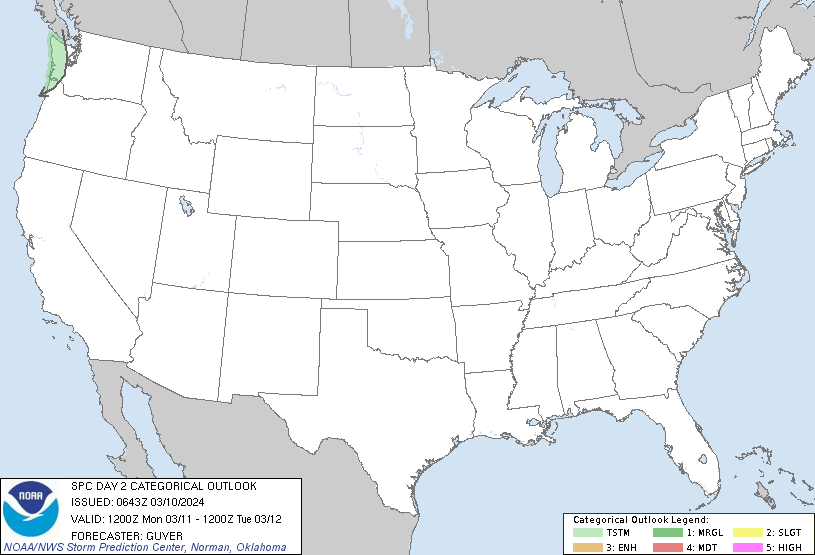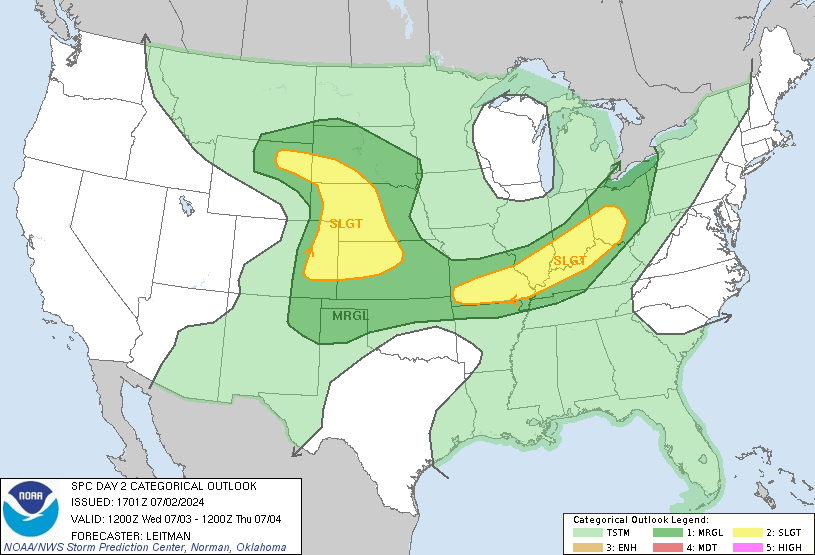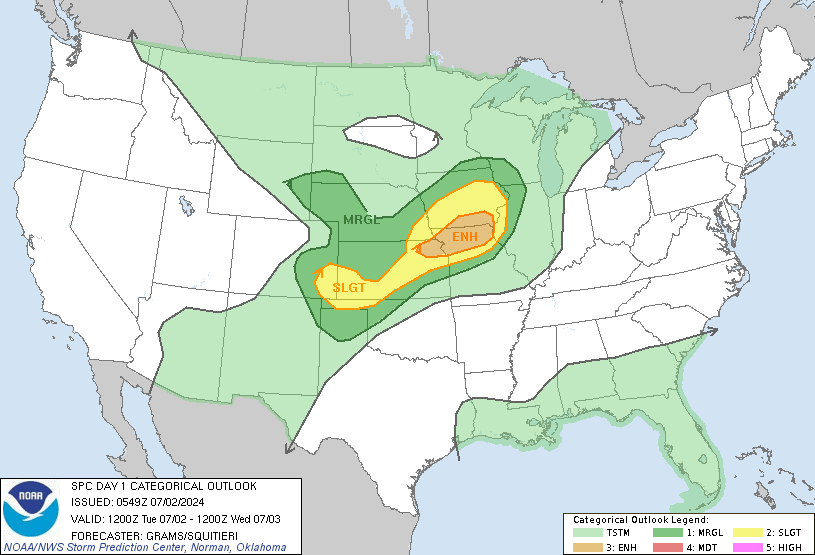Slight and Enhanced pulled a little east again. 10% hatched TOR in a corridor from S IL to N LA, interested to see if storm mode lets that play out.
Day 1 Convective Outlook
NWS Storm Prediction Center Norman OK
1146 PM CST Fri Feb 23 2018
Valid 241200Z - 251200Z
...THERE IS AN ENHANCED RISK OF SEVERE THUNDERSTORMS THIS AFTERNOON
THROUGH THIS EVENING ACROSS MUCH OF SOUTHERN AND EASTERN
ARKANSAS...NORTHERN LOUISIANA...NORTHWESTERN MISSISSIPPI....A
PORTION OF NORTHWESTERN ALABAMA...WESTERN TENNESSEE...SOUTHEASTERN
MISSOURI...SOUTHERN ILLINOIS...WESTERN KENTUCKY AND A PORTION OF
SOUTHERN INDIANA...
...THERE IS A SLIGHT RISK OF SEVERE THUNDERSTORMS ACROSS SURROUNDING
AREAS OF THE SOUTHEASTERN LOWER PLAINS...THE LOWER MISSISSIPPI AND
LOWER OHIO VALLEYS...
...THERE IS A MARGINAL RISK OF SEVERE THUNDERSTORMS SURROUNDING THE
SLIGHT RISK...AS FAR NORTH AND EAST AS THE SOUTHERN GREAT
LAKES...UPPER OHIO VALLEY AND WESTERN SLOPES OF THE APPALACHIANS BY
DAYBREAK SUNDAY...
...SUMMARY...
Severe thunderstorms are expected to develop today through tonight
across the Ark-La-Tex region, east northeastward through the lower
Mississippi and Ohio Valleys. These will be accompanied by
potential for damaging wind gusts and a few tornadoes, a couple of
which could be strong.
...Discussion...
Subtropical ridging centered near the south Atlantic coast continues
to weaken, but appears likely to maintain a prominent influence
across much of the Southeast through this period. As it does, a
vigorous and progressive short wave trough, now beginning to pivot
northeast of the Four Corners region, is forecast to take on a
negative tilt and accelerate northeastward through the Upper Midwest
by 12Z Sunday, as another significant upstream short wave trough
digs across the Great Basin. At the same time, models indicate that
a strong subtropical jet streak will nose across the Texas Big Bend
region, toward the Ozark Plateau and lower Ohio Valleys.
In response to these developments, fairly strong surface
cyclogenesis still seems probable across the central U.S. today
through tonight. There has been variability among the model output
concerning the evolution, likely at least in part due to the slow
erosion of a lingering shallow wedge of cold surface-based air over
the southern Plains. While the onset of more rapid deepening of the
surface low remains in question, it now seems most probable that
surface frontal wave development will take shape over northeastern
Oklahoma into the Missouri Ozarks by midday today, before deepening
more rapidly while migrating northeastward, and eventually occluding
over the Upper Midwest by early Sunday.
Strengthening wind fields (to 50-70 kt in the 850-500 mb layer) and
shear within a large portion of the developing warm sector will
contribute to increasing severe weather potential ahead of a
southeastward advancing cold front trailing from the surface
cyclone, as southerly return flow off the northwestern Gulf of
Mexico supports an influx of high moisture content air. However,
less than optimal thermodynamic profiles due to potential widespread
convective development and cloud cover may temper this risk
somewhat. Regardless, severe thunderstorm development still seems
probable across portions of the southeastern Plains into the Ozark
Plateau by midday, before increasing across the lower Mississippi
into lower Ohio Valleys late this afternoon and evening.
...Southern Plains into Ohio Valley...
The rather broad western/northwestern gradient of severe
probabilities is generally reflective of lingering uncertainty
concerning the specific track of the surface cyclone and timing of
its most rapid deepening. The broad eastern/southeastern gradient
generally reflects uncertainties associated with late night timing
and the likelihood of progressively weaker warm sector instability.
Severe weather potential still seems likely to become maximized
across parts of southern and eastern Arkansas into adjacent portions
of the lower Ohio Valley late this afternoon and evening, when/where
it appears that forcing for ascent and strong shear profiles may
best coincide with at least modest boundary layer instability (CAPE
on the order of 500-1000 J/kg). Substantive intensification of a
pre-frontal squall line is expected during this period, and
sustained discrete supercell development appears possible just ahead
of the line. In the presence of a moist boundary layer with surface
dew points in the mid 60s F, rather large and clockwise curved
low-level hodographs will support the risk for a few tornadoes. One
or two of these could potentially be long-lived/tracked and strong.
Otherwise, damage wind gusts are expected to become the primary
threat with the evolving line, which will spread across and east of
the lower Mississippi Valley late this evening through the overnight
hours.
It still appears that the strong/severe thunderstorm development
could commence near or shortly after day break today across parts of
central and northwest Texas. Aided by forcing for ascent associated
with low-level warm advection, beneath increasingly divergent upper
flow associated with coupling subtropical and polar jets, a sizable
cluster of storms may evolve across the Red River Valley into parts
of the Ozark Plateau through the midday/early afternoon hours. This
may mostly be rooted above lingering cold/stable surface-based air,
with severe hail the primary hazard. However, at some point this
may become increasingly rooted within a destabilizing boundary layer
across the Ark-La-Tex into the lower Mississippi Valley. As alluded
to earlier, this seems most probable across southern/eastern
Arkansas and adjacent northern Louisiana late this afternoon.
However, it is possible that a severe wind/tornado threat could
commence earlier and to the west.











